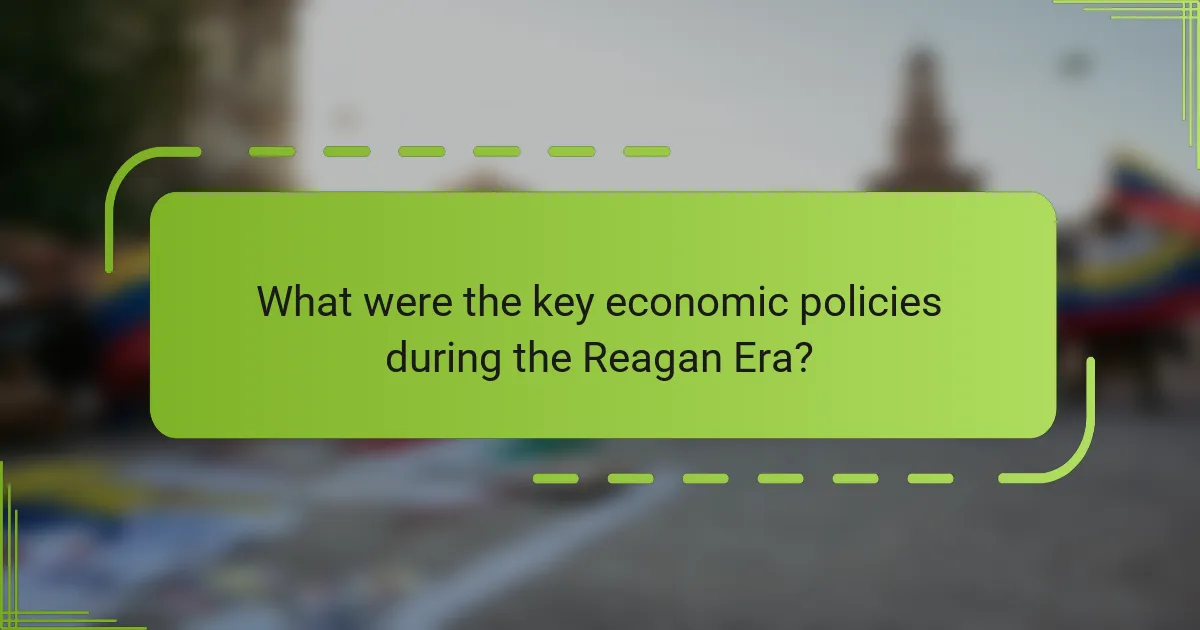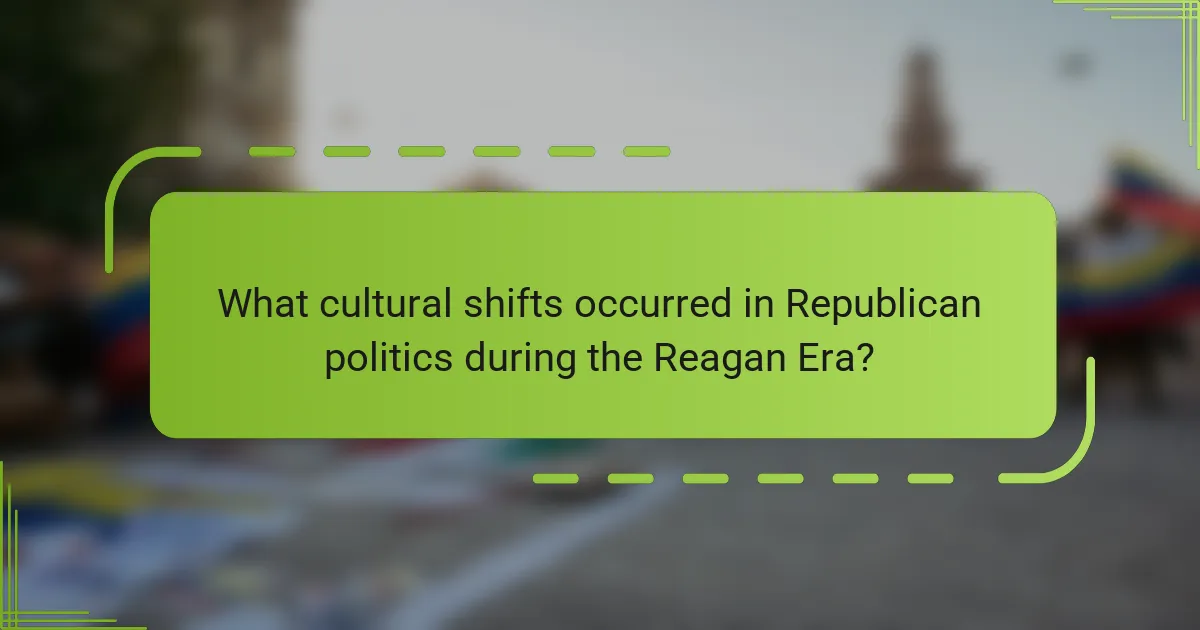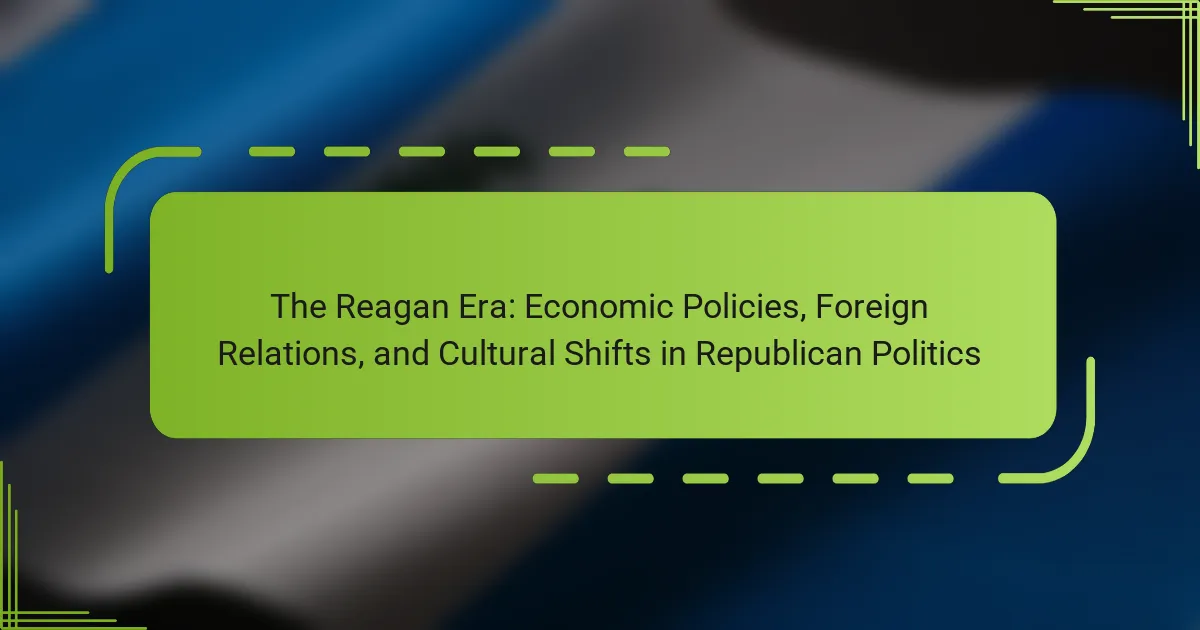
What were the key economic policies during the Reagan Era?
The key economic policies during the Reagan Era included tax cuts, deregulation, and increased military spending. Tax cuts were implemented through the Economic Recovery Tax Act of 1981, which reduced personal income tax rates by 25%. Deregulation aimed to reduce government intervention in the economy, particularly in industries like energy and transportation. The administration also focused on controlling inflation through tight monetary policy. Increased military spending was part of a strategy to strengthen national defense and counter the Soviet Union. These policies contributed to economic growth, but also resulted in significant budget deficits.
How did supply-side economics shape Reagan’s financial strategies?
Supply-side economics significantly shaped Reagan’s financial strategies by emphasizing tax cuts to stimulate economic growth. This approach aimed to increase investment and productivity by reducing the tax burden on individuals and businesses. Reagan implemented substantial tax reductions through the Economic Recovery Tax Act of 1981, which lowered the top income tax rate from 70% to 50%. The rationale was that lower taxes would incentivize spending and investment, leading to job creation.
Additionally, supply-side economics advocated for deregulation and reduced government spending. Reagan’s administration focused on cutting federal programs, which they believed would enhance efficiency and encourage private sector growth. The combination of tax cuts and deregulation was intended to create a more favorable environment for economic expansion.
The results of these strategies were mixed. While the economy experienced significant growth during the 1980s, critics argue that income inequality increased and the national debt rose sharply. Nevertheless, the core principles of supply-side economics remained influential throughout Reagan’s presidency and reshaped the Republican Party’s economic policies in subsequent years.
What are the main principles of supply-side economics?
Supply-side economics emphasizes the importance of production and supply in driving economic growth. It advocates for lower taxes to incentivize investment and increase production. The theory posits that reducing regulations can stimulate business activity. Increased supply leads to job creation and higher wages. This economic approach gained prominence during the Reagan administration in the 1980s. Historical data shows that tax cuts can lead to increased government revenue through enhanced economic activity. Supply-side economics also argues that consumers benefit from lower prices as supply increases. Overall, these principles aim to foster a favorable environment for businesses and economic expansion.
How did tax cuts impact economic growth during this period?
Tax cuts during the Reagan Era significantly stimulated economic growth. The Economic Recovery Tax Act of 1981 lowered income tax rates for individuals and businesses. This legislation aimed to increase disposable income and incentivize investment. As a result, GDP growth accelerated, averaging around 4.5% annually from 1983 to 1989. Unemployment rates also fell from over 10% in 1982 to about 5.4% by 1989. The tax cuts contributed to a surge in consumer spending and business expansion. Additionally, the stock market experienced substantial gains, reflecting increased investor confidence. Overall, the tax cuts played a crucial role in revitalizing the economy during this period.
What role did deregulation play in the Reagan administration?
Deregulation played a crucial role in the Reagan administration’s economic policies. It aimed to reduce government intervention in various industries. This approach was intended to stimulate economic growth and increase competition. The administration deregulated sectors such as transportation, telecommunications, and banking. For example, the Airline Deregulation Act of 1978, which took effect during Reagan’s presidency, eliminated price controls and allowed airlines to set their fares. This led to increased competition and lower fares for consumers. Additionally, the deregulation of the banking industry contributed to the savings and loan crisis of the late 1980s. Overall, deregulation was a key strategy to promote free-market principles during Reagan’s presidency.
Which industries were most affected by deregulation?
The industries most affected by deregulation include telecommunications, transportation, and energy. Deregulation in telecommunications led to increased competition and innovation, particularly with the breakup of AT&T in 1984. In transportation, the Airline Deregulation Act of 1978 resulted in lower fares and more flight options. The energy sector saw significant changes with the deregulation of natural gas and electricity markets, leading to fluctuating prices. These changes were part of broader economic policies during the Reagan Era aimed at promoting free-market principles.
How did deregulation influence competition and consumer choice?
Deregulation significantly increased competition and enhanced consumer choice. It removed government restrictions on industries, allowing new entrants to compete. This led to lower prices and improved services. For example, the airline industry saw a dramatic increase in carriers after deregulation in 1978. Consequently, consumers benefited from more flight options and reduced fares. Similarly, the telecommunications sector experienced growth in service providers, resulting in diverse plans and pricing. Studies show that deregulated markets often lead to innovation and better customer satisfaction. Overall, deregulation fostered a more dynamic marketplace.

What were the major foreign relations strategies of the Reagan Era?
The major foreign relations strategies of the Reagan Era included a strong anti-communist stance, arms control negotiations, and the promotion of democracy. Reagan’s administration focused on containing Soviet influence globally. The Reagan Doctrine supported anti-communist movements in countries like Nicaragua and Afghanistan. Strategic Defense Initiative (SDI) aimed to develop missile defense systems to protect against nuclear threats. Reagan also engaged in arms reduction talks with the Soviet Union, leading to the Intermediate-Range Nuclear Forces Treaty in 1987. His administration emphasized military buildup to deter Soviet aggression. These strategies reflected a shift from détente to a more confrontational approach.
How did the Reagan Doctrine redefine U.S. foreign policy?
The Reagan Doctrine redefined U.S. foreign policy by prioritizing support for anti-communist insurgencies. This approach marked a shift from previous policies of containment to active intervention. The doctrine aimed to reduce Soviet influence globally. It led to U.S. involvement in conflicts in Nicaragua, Afghanistan, and Angola. In Nicaragua, the U.S. supported the Contras against the Sandinista government. In Afghanistan, the CIA provided aid to mujahideen fighters resisting Soviet occupation. This strategy contributed to the eventual collapse of the Soviet Union. The Reagan Doctrine emphasized military aid and covert operations as key tools in foreign policy.
What were the key objectives of the Reagan Doctrine?
The key objectives of the Reagan Doctrine were to combat the spread of communism and to support anti-communist insurgencies. This policy aimed to reduce Soviet influence globally. The Reagan administration provided military and financial assistance to various groups resisting communist governments. Notable examples include support for the Contras in Nicaragua and the Mujahideen in Afghanistan. The doctrine signified a shift in U.S. foreign policy towards a more aggressive stance against perceived communist threats. It was articulated in a speech by President Reagan in 1985. The approach emphasized a commitment to promoting democracy and freedom worldwide. Ultimately, the Reagan Doctrine contributed to the end of the Cold War by undermining Soviet-backed regimes.
How did this doctrine impact U.S. relations with the Soviet Union?
The Reagan Doctrine significantly impacted U.S. relations with the Soviet Union by promoting aggressive opposition to Soviet influence worldwide. This doctrine aimed to support anti-communist movements in various countries. It marked a shift from détente to a more confrontational stance. The U.S. increased military aid to insurgent groups fighting Soviet-backed regimes. This approach heightened tensions and contributed to the arms race. It also led to the U.S. supporting the Mujahideen in Afghanistan, directly challenging Soviet forces. The doctrine reinforced the narrative of the U.S. as a global leader against communism. Ultimately, it played a role in the eventual dissolution of the Soviet Union.
What was the significance of the Iran-Contra Affair in Reagan’s foreign policy?
The Iran-Contra Affair significantly impacted Reagan’s foreign policy by revealing covert operations that contradicted public policy statements. It involved secret arms sales to Iran, despite an arms embargo, to fund Contra rebels in Nicaragua. This operation was intended to combat leftist movements in Central America, aligning with Reagan’s anti-communist stance. The affair led to a political scandal, raising questions about executive power and accountability. Congressional investigations revealed a lack of oversight and transparency in foreign policy decisions. Ultimately, it underscored the complexities and contradictions within Reagan’s foreign policy approach during the Cold War era.
What were the events leading up to the Iran-Contra Affair?
The events leading up to the Iran-Contra Affair involved multiple geopolitical factors. In the early 1980s, the U.S. supported the Nicaraguan Contras, a rebel group fighting the Sandinista government. The Sandinistas were supported by the Soviet Union, raising U.S. concerns about communism in Central America. Congress passed the Boland Amendment in 1984, restricting U.S. aid to the Contras. Despite this, the Reagan administration sought ways to continue support for the Contras. At the same time, Iran was engaged in the Iran-Iraq War and sought U.S. arms. The U.S. aimed to improve relations with Iran to secure the release of American hostages held by Hezbollah in Lebanon. This led to a covert operation where arms were sold to Iran, and profits were funneled to the Contras. These events culminated in the Iran-Contra Affair, which was publicly revealed in 1986.
How did the scandal affect Reagan’s presidency and public perception?
The scandal significantly impacted Reagan’s presidency and public perception. It led to decreased trust in his administration. Polls indicated a drop in approval ratings during the scandal. Public confidence in Reagan’s leadership wavered as allegations surfaced. The Iran-Contra affair revealed secret dealings that contradicted his policies. Critics argued this undermined his credibility on foreign policy. Media coverage intensified scrutiny of his administration. Ultimately, the scandal shaped a more skeptical view of Reagan’s presidency among the public.

What cultural shifts occurred in Republican politics during the Reagan Era?
Cultural shifts in Republican politics during the Reagan Era included a strong emphasis on conservative values. The era marked a resurgence of traditional family values and religious influence in politics. Ronald Reagan’s presidency promoted a narrative of American exceptionalism. This narrative emphasized patriotism and a rejection of perceived liberal excesses.
The Republican Party increasingly aligned with evangelical Christians during this time. Issues such as abortion and school prayer became central to the party’s platform. The era also saw a rise in anti-communism rhetoric, framing the Soviet Union as a moral enemy. This cultural shift solidified the party’s base among conservative voters and reshaped its identity for decades.
These changes were evident in the 1980 Republican National Convention, which highlighted social conservatism. The Moral Majority, founded in 1979, played a significant role in mobilizing voters around these cultural issues. Overall, the Reagan Era established a lasting legacy of conservative cultural politics within the Republican Party.
How did Reagan’s presidency influence the Republican Party’s identity?
Reagan’s presidency significantly shaped the Republican Party’s identity by promoting conservative values. His administration emphasized limited government, free-market economics, and a strong national defense. Reagan’s communication style resonated with the public, earning him the nickname “The Great Communicator.” He successfully united various factions within the party, including fiscal conservatives and social conservatives. His policies, such as tax cuts and deregulation, became foundational to modern Republican ideology. The 1980 election victory marked a shift towards a more assertive Republican stance on social issues. Reagan’s legacy also solidified the party’s alignment with evangelical Christians. Overall, his presidency established a framework that continues to influence Republican identity today.
What were the core values promoted by Reagan that resonated with voters?
The core values promoted by Reagan that resonated with voters included limited government, individual freedom, and strong national defense. Reagan emphasized the importance of free-market principles. He believed that reducing the size of government would lead to economic growth. Reagan’s policies aimed to lower taxes and deregulate industries. This approach appealed to many Americans seeking economic opportunity. Additionally, he championed traditional family values and patriotism. Reagan’s strong stance against communism resonated during the Cold War. His optimistic vision of America inspired confidence among voters.
How did the rise of evangelical Christians impact Republican politics?
The rise of evangelical Christians significantly influenced Republican politics by mobilizing a substantial voting bloc. This demographic shift began in the late 1970s and gained momentum during the Reagan administration. Evangelicals prioritized social issues such as abortion, family values, and religious freedom. Their activism led to the Republican Party adopting a platform that aligned closely with these concerns. In the 1980 election, Reagan secured a large portion of the evangelical vote, which contributed to his landslide victory. This alliance between evangelicals and Republicans solidified a long-term relationship that shaped party policies and strategies. The influence of evangelical Christians continues to be a defining feature of Republican politics today.
What role did media play in shaping public perception of Reagan?
Media played a crucial role in shaping public perception of Reagan. The coverage of his presidency influenced how Americans viewed his policies and personality. Television played a significant part during Reagan’s campaigns. His charismatic presence resonated with viewers, enhancing his appeal. The media often portrayed him as a strong leader. This portrayal aligned with his “Morning in America” campaign theme. Additionally, media coverage of his economic policies affected public opinion. Positive reporting on economic recovery helped bolster his image. Conversely, negative coverage of foreign policy issues, like Iran-Contra, challenged his credibility. Overall, media shaped both favorable and unfavorable perceptions of Reagan throughout his presidency.
How did Reagan utilize television to communicate with the public?
Reagan effectively utilized television to communicate with the public by leveraging its visual medium. He became known for his charismatic presence and effective messaging. Reagan’s use of television included regular broadcasts, such as the weekly radio address that was televised. He also engaged in televised press conferences, which allowed him to connect directly with viewers. His speeches often featured emotional appeals and storytelling, making complex policies more relatable. The “Great Communicator” label stemmed from his ability to simplify issues for the audience. For instance, his 1984 re-election campaign featured memorable advertisements that resonated with voters. Reagan’s televised performances contributed to shaping public perception and garnering support for his policies.
What were the effects of media portrayal on Reagan’s political legacy?
Media portrayal significantly shaped Reagan’s political legacy. Positive coverage emphasized his charisma and leadership style. This portrayal helped establish him as a transformative figure in American politics. Conversely, critical media narratives highlighted his administration’s controversies, such as the Iran-Contra affair. These contrasting depictions influenced public perception and approval ratings. Studies show that media framing can impact political legacies over time. For instance, Reagan’s image as a strong leader contributed to his lasting popularity among conservatives. Overall, media portrayal played a crucial role in defining and sustaining Reagan’s legacy in American history.
What lessons can be learned from the Reagan Era for today’s political landscape?
The Reagan Era teaches valuable lessons about effective communication and coalition building in politics. Ronald Reagan’s ability to connect with diverse audiences was pivotal. His optimistic messaging resonated with many Americans during challenging times.
Additionally, the importance of a clear economic vision is evident. Reagan’s supply-side economic policies aimed to stimulate growth through tax cuts. This approach contributed to a significant economic recovery in the 1980s.
Furthermore, the Reagan administration emphasized strong foreign policy stances. Its focus on combating communism shaped global relations and established the U.S. as a dominant force.
Lastly, the era highlights the significance of cultural engagement. Reagan’s appeal to traditional values helped solidify a Republican base. These lessons remain relevant as today’s political landscape continues to evolve.
How can current leaders apply Reagan’s economic strategies?
Current leaders can apply Reagan’s economic strategies by emphasizing tax cuts, deregulation, and a focus on free-market principles. Reagan implemented significant tax reductions to stimulate economic growth. For example, the Economic Recovery Tax Act of 1981 reduced individual income tax rates by 25%. Current leaders can adopt similar tax policies to encourage investment and consumer spending.
Deregulation was another hallmark of Reagan’s approach. He reduced government intervention in various industries, leading to increased competition and innovation. Leaders today can evaluate regulations that may hinder economic growth and consider reforms to promote a more business-friendly environment.
Additionally, Reagan advocated for a strong national defense, which he believed would bolster economic confidence. Current leaders can prioritize defense spending to create jobs and stimulate economic activity.
Overall, implementing these strategies can help current leaders foster economic growth and stability, as evidenced by the robust economic expansion during Reagan’s presidency, which saw GDP growth averaging 3.5% annually from 1982 to 1989.
What insights from Reagan’s foreign policy can guide modern diplomacy?
Reagan’s foreign policy emphasizes the importance of strong alliances in modern diplomacy. He fostered partnerships with NATO allies to counter Soviet influence. This collaborative approach led to the successful containment of communism during the Cold War. Additionally, Reagan’s focus on diplomacy through strength showcased the effectiveness of military readiness. His administration increased defense spending, which pressured the Soviet Union economically. This strategy illustrates that demonstrating power can lead to successful negotiations. Finally, Reagan’s willingness to engage in dialogue with adversaries, as seen in his talks with Gorbachev, highlights the value of open communication in resolving conflicts.
The main entity of the article is the Reagan Era, focusing on its economic policies, foreign relations, and cultural shifts within Republican politics. Key economic policies during this period included tax cuts, deregulation, and increased military spending, which were influenced by supply-side economics and aimed at stimulating growth. The article also examines the Reagan Doctrine, which redefined U.S. foreign policy by supporting anti-communist movements and fostering military readiness. Additionally, it highlights cultural shifts, such as the alignment with evangelical Christians and the emphasis on conservative values, shaping the Republican Party’s identity. Overall, the article provides a comprehensive overview of the significant impacts of Reagan’s presidency on both domestic and foreign fronts.
